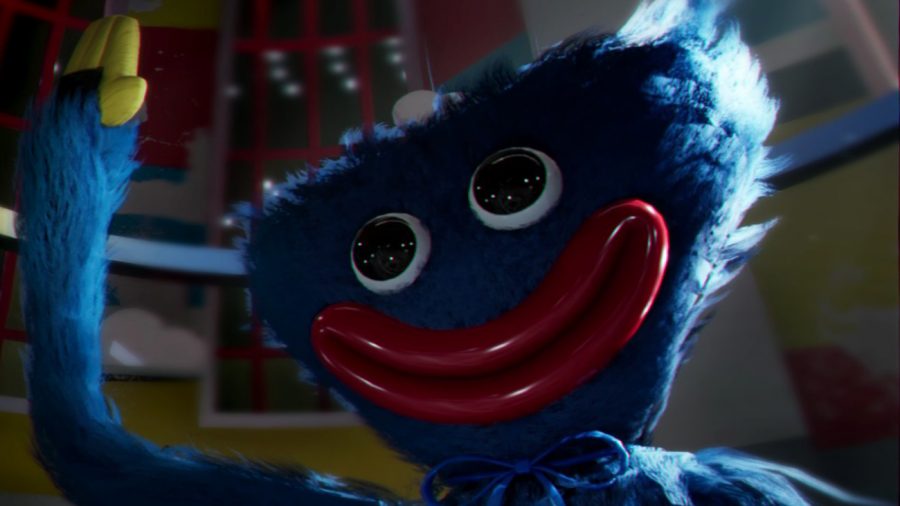The Upcoming Horror Game That Has Everyone Hooked
November 23, 2021
Six-feet-tall, blue and fuzzy, with limbs that scrape the floor as he walk with a lumbering, stuttered gait, and sweet-turned-menacing grin that reveals rows upon rows of teeth, below eyes of shiny plastic that seem to hold something more real, incredibly life-like behind them…This is the antagonist of chapter one of the game Poppy Playtime, with this terrifying creation known as “Huggy Wuggy.”
Poppy Playtime–released on Oct. 21, 2021,–currently only has one chapter for this game out to the public, but already the short segment of playtime and lore has gained a wide variety of attention and heightened interest. Within only a couple of weeks since its release, videos and blogs have already been made showcasing how players are “breaking” the game, or at the very least pushing it past its limits, and also staging a variety of theories and ideas about the story, characters, and lore of this to-be-continued game. With a release date for chapter two set at some unknown time at the beginning of 2022, these are really the only few things that fast-fans of this game can do for now, and it seems as though the hype train for this story isn’t going to slow down.
But, why has it gotten so popular? Simple: a combination of old and new.
Throughout the years, time and time again, there has been a noticeable trend of using “old,” or things that fuel people’s nostalgia, and applying them to the horror genre. With movies like the Chucky series, and games like Five Nights at Freddy’s and Tattletail, it’s clear to see how effective taking elements from people’s childhoods and twisting them into something new and terrifying—along with bringing it into the “modern era”—can create another level of horror that still seems somewhat new to the genre.
In Poppy Playtime, the characters, gameplay, audio, visuals, and story all collectively combine together to create that uneasy, eerie feeling that is often produced from things that are just the right amount of “old” and “new.” This combination is not only what draws people into the game but keeps them interested, along with all other elements of the game wrapping them in like the protagonist in one of Huggy Wuggy’s “hugs.”
Speaking of the other aspects of the game, they absolutely should not be forgotten. The main idea of the game’s plot is that the nameless and faceless protagonist—an ex-employee of a well-renowned toy company called Playtime Co., who known for making the most life-like toys, and specializing in making “the nation’s favorite toys”—one day receives a mysterious letter, littered with misspellings and a very-noticeable uneasy feeling, with said letter urging the protagonist to come back to the factory where they use to work, stating how people believed the workers to have suddenly disappeared 10 years ago but claiming that they are all still there. With the letter urging the protagonist to search for them and to “find the flower,” along with photographs and a VHS tape—which plays at the beginning of the game for the player—in the same package, the game jumps to the protagonist instantly being inside the front of the factory. From there, the player must figure out a variety of puzzles from the beginning to the near end of the game, all requiring the usage of the Grabpack, which is basically an over-glorified set of arcade-prize sticky hands that can conduct electricity, grab small items, and reach things that are far-away, and are essentially the player’s only way to grab items and interact with the game world.
During chapter one, the player encounters Huggy Wuggy near the very start of it, with Huggy Wuggy being a “model” of the classic toy that the company sells—and sells the most of—but with the normal toy being about or less than one foot in height, the “model” of the Huggy Wuggy displayed in the central area of the factory is three, four times the height of the protagonist. Huggy Wuggy is seen to be a sort of mascot for the company, as his image is displayed throughout the factory on the walls, on posters, etc., and the sign in front of his display tells the player this, along with the fact that he is the most popular toy sold from Playtime Co.
He is covered in wild blue fur, has long and gangly limbs, and an oddly shaped head, with large, bulbous eyes (which, when more closely looked at, seems to actually possess realistic, more human-like eyes inside of them, which constantly follow the player), and large red lips permanently stuck in a large smile. His arm is raised in a sort of welcoming or greeting gesture, and it doesn’t seem to be all that scary until the player can notice the minor movement Huggy seems to make, as if he were breathing, or when the power goes out to unlock a door needed to progress, and the only way to get into the generator room is with a key…which Huggy appears to suddenly possess and hold on the hand that is permanently raised in greeting, only gaining it after the power goes out and Huggy seems to have rapidly moved in the room to grab the key before going back into place before the player turns around, and then later disappearing completely from the room when the player turns the power back on.
From that point forward, there are moments where Huggy can be seen spying on the player and eventually confronts the player, slowly shambling towards them until they are forced to retreat into a system of vents, which is the arguably the scariest part of the game—an intense chase scene through the vents as Huggy Wuggy seems to gain inch after inch on the player, the once friendly and inviting smile a now teeth-filled grin, looking more like a hungry, rabid animal than a lovable, cuddly, giant version of a beloved children’s toy.
The player finally exits the vents, after a solid minute of high-adrenaline maze running through the vents, into a deeper part of the factory and is followed quickly by Huggy, who is sent into the abyss of mechanical machinery and tubes after the player drops a box on top of him and breaks apart the walkway under both him and the player. It is from there that the player will go on to find what is believed to be the “flower” referenced in the letter—especially given that one of the photos that the player gets to see before the game starts up shows the exact location and the appearance of the “flower”—and gets to meet the namesake of the game, Poppy Playtime, locked in a case akin to that of the Annabelle doll. The player releases her from her case, the screen goes black, Poppy seems surprised that the player let her out, and chapter one ends.
In general, the bare minimum amount of time someone could spend playing this game, from start to finish of chapter one, is only around eight minutes—only eight minutes is around the fastest time a player could complete chapter one in. Only that short amount of time, and yet no one has pushed this game off to the side after getting bored from the “lack of content” or “short gameplay”—in fact, weeks later, people are still talking about it, still making theories and ideas based on what little is known so far, still showing their love and appreciation for what is all currently there. Why?
Aside from the fact that this game takes the idea of “old and new” and runs off with it, and that the vent chase scene is sure to give even repeat-visitors an adrenaline rush, this game could not work if it weren’t for the fact that it thrives off of story-building, characterization, environment, personality, and attention to detail. To go back on the idea of “old and new,” one only has to take a look at the state of the factory’s entrance way the second the game boots up the player inside the factory to tell how this idea is put into actualization.
This concept is all-throughout the game, and how they made the idea actualized with the environment and various aspects of the game is numerous, beautiful-crafted, and astoundingly well done—-the way the walls that are clearly meant to be bright and colorful, with colorful and fun pictures of Huggy Wuggy, and some of the other toy characters that Playtime Co. create, are worned-down, scratched up, and chipping; the colorful floor tiles are smudged and lined with dirt, covered in debris like leaves and mud, and are utterly scuffed up; the minimal areas that are lit up so that rooms are still entirely visible, but the parts that don’t get a lot of light are casted in long, dark shadows, and make the player feel like the shadows outweigh the areas in light; the literally of posters that have the likeness of the companies personified toy characters on them alongside strange and somewhat creepy rules, or reminders of things to do, like to take breaks (that don’t exceed 10 minutes) and to adopt orphans, some hinting at the speculated or believed ideas for the game’s lore and story-lore; the grimy, industrial and soulless atmosphere, especially as the player gets deeper into the factory; the placement of toys around the factory, the placement of the broken toys in the factory, and how most of the broken toys discarded on the floor appear to be accompanied by blood splatters; the bright color scheme of the toys, the pieces that are needed to solve the puzzles, and anything that is not directly “human,” while anything that directly is “human” is in boring tones of dull and metallic grays and has a sense of soullessness to them; and so much, much more. The environment is so important for any form of media in the horror genre, and Poppy Playtime’s matches the energy and expectations the creators had set for it.
Another likely big pull for the series, even thus far, is the story, the revealed or hinted-at lore, and all of the theories people have been speculating and putting out there, thus far. Even with what little information that has been provided so far through just chapter one of the game, multitudes of theories about certain aspects of the game, of the story, etc. have cropped up, and continue to do so. Even if the hype cools down between the present moment and when chapter two is released, the fact remains that a decent portion of people will still likely continue to theorize from now until then.
All in all, despite how little gameplay there is in Poppy Playtime, especially when it is subject to have likely multiple chapters to be added later on as the game progresses and is developed more and more, it is still easily one of the up-and-coming serieses to have really caught the interest of the horror video game community. Despite how short the game technically is in its current state, the sheer amount of store, lore, and development that has already been implemented into the game thus far will keep general observers, horror fans, and now Poppy Playtime fans alike interested for quite some time, and speculating on what everything and anything in the game could potentially mean, from now until the chapter two release. One thing is definitely for certain, however—Poppy Playtime is most assuredly not a game anyone will be forgetting any time soon.
(Article thumbnail image from MOB Games, creators of Poppy Playtime)








